A Framework of Sustainable Service Supply Chain Management: A Literature Review and Research Agenda
Abstract
:1. Introduction
2. Methodology
- It clearly discusses the sustainability of the supply chain including the explicit use of conceptual or empirical research to study the impact on supply chain sustainability. The explicit use means its theme has words “sustainable”, ”supply chain” or “supply network”, for example, Kannegiesse et al., 2015 [27].
- It implicitly discusses the sustainability of the supply chain, including implicitly articulating research on the value and perspective of supply chain sustainability. The implicit use means its theme does not have words “sustainable”, “supply chain” or “supply network” but the content are related with sustainable supply chain, for instance, Helin and Babri, 2014 [28].
3. Research Analysis
3.1. Sustainable Supply Chain Management: Environment and Economy Point of View
3.2. Sustainable Supply Chain Management: Society and Environment Point of View
3.3. Sustainable Supply Chain Management: Society and Economy Point of View
3.4. Sustainable Supply Chain Management: Environment, Society, and Economy Point of View
- The triple bottom line in the sustainable supply chain is explicitly discussed.
- A clear operational or regulatory framework for a sustainable supply chain is presented, including a framework that provides a valuable perspective and theoretical research on supply chain sustainability.
4. Sustainable Supply Chain Operation Framework
4.1. Manufacture Supply Chain Sustainable Framework
4.2. Service Sustainable Supply Chain Framework
5. A Framework of SSSCM Based on TBL
5.1. Service Supply Chain and Its Development
5.2. Main Sustainability Features of Service Supply Chain
5.3. Sustainable Service Supply Chain Based on TBL
5.4. A Framework of SSSCM
5.5. Research Agenda of Sustainable Service Supply Chain
- In the sustainable supply chain framework of service supply chains based on ternary theory, each individual is affected by the triple bottom line, and each individual is also an important component of the ternary relation. Therefore, the triple bottom line’s interaction to the ternary relation and its mechanism of action will be worthy of further study.
- In the framework of sustainable service supply chain management based on ternary theory, it is important to consider the constraints of the triple bottom line and to design the corresponding service supply chain strategy. These important strategies will include the interaction research of the standardization of services in the supply chain strategy, upstream and downstream supply chain relationship management, customer satisfaction and supplier support, supply chain risk, and profit-sharing tripartite issues, which all have important research value. In these studies, one must not only consider the interactions from the supply chain ternary participants, but also take into account the constraints and impacts of TBL on these strategic designs.
- On the strategic level of service supply chain sustainable operation, some important operational strategies are still worthy of in-depth discussion. First, because of the intangible characteristics of service products, it is not easy for a service supply chain to realize the green supply chain compared with the manufacturing supply chain. Therefore, it is urgent to construct corresponding green operation requirements according to the characteristics of the service products. The whole service supply chain’s green operation and management system’s construction are worthy of in-depth study. Secondly, the coordination framework of the sustainable service supply chain based on a ternary relationship is also worthy of further study. Because it will break the previous solutions, which consider the service integrator to be the center of supply chain, a multi-agent structure will be adopted to design a supply chain that leads to a new demand for a coordination framework. Thirdly, in the operation of SSSCM, we must take into account the social responsibility and economic responsibility under the dual constraints of organizational relationship management. Lastly, consideration of the ternary relationship under service supply chain planning requirements and incentive-oriented life cycle assessments, along with provider barrier settings, are worthy of an in-depth study as well.
6. Conclusions
Supplementary Files
Supplementary File 1Acknowledgments
Author Contributions
Conflicts of Interest
References
- Powell, D. ERP systems in lean production: New insights from a review of lean and ERP literature. Int. J. Oper. Prod. Manag. 2013, 33, 1490–1510. [Google Scholar] [CrossRef]
- Beheshti, H.M.; Blaylock, B.K.; Henderson, D.A.; Lollar, J.G. Selection and critical success factors in successful ERP implementation. Competitiveness Rev. 2014, 24, 357–375. [Google Scholar] [CrossRef]
- Vezzetti, E.; Alemanni, M. Supporting product development in the textile industry through the use of a product lifecycle management approach: A preliminary set of guidelines. Int. J. Adv. Manuf. Technol. 2015, 79, 1493–1504. [Google Scholar] [CrossRef]
- Mesihovic, S.; Malmqvist, J.; Pikosz, P. Product data management system-based support for engineering project management. J. Eng. Des. 2004, 15, 389–403. [Google Scholar] [CrossRef]
- Vezzetti, E.; Alemanni, M.; Morelli, B. New product development (NPD) of ‘family business’ dealing in the luxury industry: Evaluating maturity stage for implementing a PLM solution. Int. J. Fash. Des. Technol. Educ. 2016. [Google Scholar] [CrossRef]
- Masters, J.M.; Pohlen, T.L. Evolution of the Logistics Profession. In The Logistics Handbook; Free Press: New York, NY, USA, 1994. [Google Scholar]
- Langley, C.J. The evolution of the logistics concept. J. Bus. Logist. 1986, 7, 1–13. [Google Scholar]
- Roth, A.V.; Manor, L.J. Insights into service operations management: A research agenda. Prod. Oper. Manag. 2003, 12, 145–164. [Google Scholar] [CrossRef]
- Linton, J.D.; Klassen, R.; Jayaraman, V. Sustainable Supply Chains: An Introduction. J. Oper. Manag. 2007, 42, 451–469. [Google Scholar] [CrossRef]
- Seuring, S.; Muller, M. Core issues in sustainable supply chain management—A delphi study. Bus. Strategy Environ. 2008, 17, 455–466. [Google Scholar] [CrossRef]
- Carter, C.R.; Rogers, D.S. A framework of sustainable supply chain management: Moving toward new theory. Int. J. Phys. Distrib. Logist. Manag. 2008, 38, 360–387. [Google Scholar] [CrossRef]
- Ellram, L.M.; Tate, W.L.; Billington, C. Understanding and Managing the Service Supply Chain. J. Supply Chain Manag. 2004, 40, 17–32. [Google Scholar] [CrossRef]
- Wang, Y.L.; Wallace, S.W.; Shen, B.; Choi, T.M. Service supply chain management: A review of operational models. Eur. J. Oper. Res. 2015, 247, 685–698. [Google Scholar] [CrossRef]
- Baltacioglu, T.; Ada, E.; Kaplan, M.D.; Yurt, O.; Kaplan, Y.C. A new framework for service supply chains. Serv. Ind. J. 2007, 27, 105–124. [Google Scholar] [CrossRef]
- Demirkan, H.; Cheng, H. The risk and information sharing of application services supply chain. Eur. J. Oper. Res. 2008, 187, 765–784. [Google Scholar] [CrossRef]
- Sampson, S.E.; Spring, M. Customer roles in service supply chains and opportunities for innovation. J. Supply Chain Manag. 2012, 48, 30–50. [Google Scholar] [CrossRef]
- Liu, W.; Liang, Z.; Ye, Z.; Liu, L. The optimal decision of customer order decoupling point for order insertion scheduling in logistics service supply chain. Int. J. Prod. Econ. 2016, 175, 50–60. [Google Scholar] [CrossRef]
- Hussain, M.; Khan, M.; Al-Aomar, R. A framework for supply chain sustainability in service industry with CFA. Renew. Sustain. Energy Rev. 2015, 55, 1301–1312. [Google Scholar] [CrossRef]
- Zhao, M. 27 Logistic Vehicles Are Reported to Be Emission Exceeded. Available online: http://news.163.com/14/0530/05/9TFJCLI800014AED.html (accessed on 16 January 2017). (In Chinese)
- Fast Hotel Washed Out White Bed Sheets with Caustic Soda Blending Detergent. Available online: http://www.bj.xinhuanet.com/bjyw/yqphb/2016-04/18/c_1118650311.htm (accessed on 16 January 2017). (In Chinese)
- Tourism B2B Capital Chain Rupture Run Case Appear Frequently: Following Yoke and Daily Trip, Chiyu Tourism Company Frankly Make Acknowledgement of a Debt 270 Million Yuan. Available online: http://mt.sohu.com/20161111/n472958126.shtml (accessed on 16 January 2017). (In Chinese)
- Mayring, P. Quanlitative Inhaltanalyse-Grundlagen und Tchniken, 8th ed.; Beltz Verlag: Weinheim, Germany, 2003. [Google Scholar]
- Reim, W.; Paride, V.; Qrtqvist, D. Product-Service System (PSS) business models and tactics—A systematic literature review. J. Clean. Prod. 2015, 97, 61–75. [Google Scholar] [CrossRef]
- Agrawal, S.; Singh, R.K.; Murtaza, Q. A literature review and perspectives in reverse logistics. Resour. Conserv. Recycl. 2015, 97, 76–92. [Google Scholar] [CrossRef]
- Lotfizadeh, A.D.; Edwards, T.L.; Poling, A. Motivating operations in the Journal of Organizational Behavior Management: Review and discussion of relevant articles. J. Organ. Behav. Manag. 2014, 34, 69–103. [Google Scholar]
- Seuring, S.; Mueller, M. From a literature review to a conceptual framework for sustainable supply chain management. J. Clean. Prod. 2008, 16, 1699–1710. [Google Scholar] [CrossRef]
- Kannegiesser, M.; Günther, H.O.; Autenrieb, N. The Time-to-Sustainability Optimization Strategy for Sustainable Supply Network Design. J. Clean. Prod. 2015, 108, 451–463. [Google Scholar] [CrossRef]
- Helin, S.; Babri, M. Travelling with a code of ethics: A contextual study of a Swedish MNC auditing a Chinese supplier. J. Clean. Prod. 2014, 107, 41–53. [Google Scholar] [CrossRef]
- Sengupta, K.; Heiser, D.R.; Cook, L.S. Manufacturing and Service Supply Chain Performance: A Comparative Analysis. J. Supply Chain Manag. 2006, 42, 4–15. [Google Scholar] [CrossRef]
- Zhou, M.; Park, T.; Yi, J. Commonalities and Differences between Service and Manufacturing Supply Chains: Combining Operations Management Studies with Supply Chain Management. Calif. J. Oper. Manag. 2009, 7, 136–143. [Google Scholar]
- Anderson, E.G.; Mortice, D.J.; hmdeen, G. The “Physics” of Capacity and Backlogmangement in Service and Custom Manufacturing Supply Chains. Syst. Dyn. Rev. 2005, 21, 217–247. [Google Scholar] [CrossRef]
- Wei, Y.; Hu, Q.; Xu, C. Ordering, pricing and allocation in a service supply chain. Int. J. Prod. Econ. 2013, 144, 590–598. [Google Scholar] [CrossRef]
- Liu, W.; Wang, S.; Chen, L. The role of control power allocation in service supply chains: Model analysis and empirical examination. J. Purch. Supply Manag. 2017, in press. [Google Scholar] [CrossRef]
- Murphy, P.R.; Poist, R.F.; Braunschweig, C.D. Management of environmental issuesin logistics: Current status and future potential. Transp. J. 1994, 34, 48–56. [Google Scholar]
- Ferdows, K. Shaping global operations. J. Globlization Competitiveness Governability 2009, 3, 136–148. [Google Scholar]
- Seuring, S. A review of modeling approaches for sustainable supply chain management. Decis. Support Syst. 2013, 54, 1513–1520. [Google Scholar] [CrossRef]
- You, F.; Wang, B. Life cycle optimization of biomass-to-liquid supply chains with distributed centralized processing networks. Ind. Eng. Chem. 2011, 50, 10102–10127. [Google Scholar] [CrossRef]
- Genovese, A.; Acquaye, A.A.; Figueroa, A.; Koh, S.C.L. Sustainable supply chain management and the transition towards a circular economy: Evidence and some applications. Omega 2015, 66, 344–357. [Google Scholar] [CrossRef]
- Hasan, M. Sustainable Supply Chain Management Practices and Operational Performance. Am. J. Ind. Bus. Manage. 2013, 3, 42–48. [Google Scholar] [CrossRef]
- Omer, A.M. Energy, environment and sustainable development. Renew. Sustain. Energy Rev. 2008, 12, 2265–2300. [Google Scholar] [CrossRef]
- Brandenburg, M.; Govindan, K.; Sarkis, J.; Seuring, S. Quantitative models for sustainable supply chain management: Developments and directions. Eur. J. Oper. Res. 2014, 233, 299–312. [Google Scholar] [CrossRef]
- Beske, P.; Land, A.; Seuring, S. Sustainable supply chain management practices and dynamic capabilities in the food industry: A critical analysis of the literature. Int. J. Prod. Econ. 2014, 152, 131–143. [Google Scholar] [CrossRef]
- SAI (2008). SA8000: Social Accountability International. New-York. Available online: http://www.sa-intl.org/index.cfm?fuseaction=Page.viewPage&pageId=937&parentID=479&nodeID=1 (accessed on 13 April 2016).
- European Commission (2009). EMAS-The European Eco-Management and AuditScheme, European Union, Belgium. Available online: http://ec.europa.eu/environment/emas/index_en.htm (accessed on 13 April 2016).
- Carroll, A.B. A three-dimensional conceptual model of corporate performance. Acad. Manag. Rev. 1979, 4, 497–505. [Google Scholar]
- Clarkson, M. A stakeholder framework for analyzing and evaluating corporate social performance. Acad. Manag. Rev. 1995, 20, 42–56. [Google Scholar]
- Wood, D.J. Corporate social performance revisited. Acad. Manag. Rev. 1991, 16, 691–718. [Google Scholar]
- Berry, M.A.; Rondinelli, D.A. Proactive corporate environmental management: A new industrial revolution. Acad. Manag. Perspect. 1998, 12, 38–50. [Google Scholar] [CrossRef]
- Azapagic, A.; Perdan, S. Indicators of sustainable development for industrya general framework. Process Saf. Environ. 2000, 78, 243–261. [Google Scholar] [CrossRef]
- Carter, C.R.; Jennings, M.M. Logistics social responsibility: An integrative framework. J. Bus. Logist. 2002, 23, 145–178. [Google Scholar] [CrossRef]
- Hutchins, M.J.; Sutherland, J.W. An exploration of measures of social sustainability and their application to supply chain decisions. J. Clean. Prod. 2008, 16, 1688–1698. [Google Scholar] [CrossRef]
- Matos, S.; Hall, J. Integrating sustainable development in the supply chain: The case of life cycle assessment in oil and gas and agricultural biotechnology. J. Oper. Manag. 2007, 25, 1083–1102. [Google Scholar] [CrossRef]
- O’Connor, M.; Spangenberg, J.H. A methodology for CSR reporting: Assuring a representative diversity of indicators across stakeholders, scales, sites and performance issues. J. Clean. Prod. 2008, 16, 1399–1415. [Google Scholar] [CrossRef]
- Foerstl, K.; Reuter, C.; Hartmann, E.; Blome, C. Managing supplier sustainability risks in a dynamically changing environment—Sustainable supplier management in the chemical industry. J. Purch. Supply Manag. 2010, 16, 118–130. [Google Scholar] [CrossRef]
- Gimenez, C.; Sierra, V.; Rodon, J. Sustainable operations: Their impact on the triple bottom line. Int. J. Prod. Econ. 2012, 140, 149–159. [Google Scholar] [CrossRef]
- Castka, P.; Balzarova, M. ISO 26000 and supply chains—On the diffusion of the social responsibility standard. Int. J. Prod. Econ. 2008, 111, 274–286. [Google Scholar] [CrossRef]
- Rubio, S.; Corominas, A. Optimal manufacturing-remanufacturing policiesin a lean production environment. Comput. Ind. Eng. 2008, 55, 234–242. [Google Scholar] [CrossRef]
- Tseng, M.; Divinagracia, L.; Divinagracia, R. Evaluating firm’s sustainable Production indicators in uncertainty. Comput. Ind. Eng. 2009, 57, 1393–1403. [Google Scholar] [CrossRef]
- Eskandarpour, M.; Pierre, D.; Joe, M.; Olivier, P. Sustainable supply chain network design: An optimization-oriented review. Omega 2015, 54, 11–32. [Google Scholar] [CrossRef]
- Jorgensen, A. SocialLCA—A way ahead? Int. J. Life Cycle Assess. 2013, 18, 296–299. [Google Scholar] [CrossRef]
- Grimm, J.H.; Hofstetter, J.S.; Sarkis, J. Critical factors for sub-supplier management: A sustainable food supply chains perspective. Int. J. Prod. Econ. 2014, 152, 159–173. [Google Scholar] [CrossRef]
- Ramos, T.R.P.; Gomes, M.I.; Barbosa-Póvoa, A.P. Planning a sustainable reverse logistics system: Balancing costs with environmental and social concerns. Omega 2014, 48, 60–74. [Google Scholar] [CrossRef]
- Wood, L.C. Investigating the formation of service supply chains. Serv. Ind. J. 2015, 35, 5–23. [Google Scholar]
- Hahn, R. ISO 26000 and the standardization of strategic management processes for sustainability and corporate social responsibility. Bus. Strategy Environ. 2013, 22, 442–455. [Google Scholar] [CrossRef]
- Mori, K.; Christodoulou, A. A Review of sustainability indices and indicators: Towards a new City Sustainability Index (CSI). Environ. Impact Assess. Rev. 2012, 32, 94–106. [Google Scholar] [CrossRef]
- Chen, L.; Olhager, J.; Tang, O. Manufacturing facility location and sustainability: A literature review and research agenda. Int. J. Prod. Econ. 2014, 149, 154–163. [Google Scholar] [CrossRef]
- Ciliberti, F.; Pontrandolfo, P.; Scozzi, B. Logistics Social Responsibility: Standard Adoption and Practices in Italian Companies. Int. J. Prod. Econ. 2008, 113, 88–106. [Google Scholar] [CrossRef]
- Hassini, E.; Surti, C.; Searcy, C. A literature review and a case study of sustainable supply chains with a focus on metrics. Int. J. Prod. Econ. 2012, 140, 69–82. [Google Scholar] [CrossRef]
- Wu, Z.; Pagell, M. Balancing priorities: Decision-making in sustainable supply chain management. J. Oper. Manag. 2011, 29, 577–590. [Google Scholar] [CrossRef]
- Ageron, B.; Gunasekaran, A.; Spalanzani, A. Sustainable supply management: An empirical study. Int. J. Prod. Econ. 2012, 140, 168–182. [Google Scholar] [CrossRef]
- Brandenburg, M.; Rebs, T. Sustainable supply chain management: A modeling perspective. Ann. Oper. Res. 2015, 229, 213–252. [Google Scholar] [CrossRef]
- Chardine-Baumann, E.; Botta-Genoulaz, V. A framework for sustainable performance assessment of supply chain management practices. Comput. Ind. Eng. 2014, 76, 138–147. [Google Scholar] [CrossRef]
- Winkler, H. Closed-loop production systems—A sustainable supply chain approach. J. Manuf. Sci. Technol. 2011, 4, 243–246. [Google Scholar] [CrossRef]
- Amini, M.; Bienstock, C.C. Corporate sustainability: An integrative definition and framework to evaluate corporate practice and guide academic research. J. Clean. Prod. 2014, 76, 12–19. [Google Scholar] [CrossRef]
- Liu, W.H.; Ge, M.Y.; Yang, D.J. An order allocation model in a two-echelon logistics service supply chain based on the rational expectations equilibrium. Int. J. Prod. Res. 2013, 51, 3963–3976. [Google Scholar] [CrossRef]
- Liu, W.; Xie, D.; Liu, Y.; Liu, X.Y. Service capability procurement decision in logistics service supply chain: A research under demand updating and quality guarantee. Int. J. Prod. Res. 2015, 53, 488–510. [Google Scholar] [CrossRef]
- Kuei, C.-H.; Madu, C.N.; Lin, C. Developing global supply chain quality management systems. Int. J. Prod. Res. 2011, 49, 4457–4481. [Google Scholar] [CrossRef]
- Nair, A.; Vidal, J.M. Supply network topology and robustness against disruptions—An investigation using multi-agent model. Int. J. Prod. Res. 2011, 49, 1391–1404. [Google Scholar] [CrossRef]
- Finne, M.; Holmström, J. A manufacturer moving upstream: Triadic colla ration for service delivery. Supply Chain Manag. Int. J. 2012, 18, 21–33. [Google Scholar] [CrossRef]
- Wu, Z.; Choi, T.Y.; Rungtusanatham, M.J. Supplier-supplier relation ships in buyer-supplier-supplier triad s: Implications for supplier performance. J. Oper. Manag. 2010, 28, 115–123. [Google Scholar] [CrossRef]
- Dou, Y.; Sarkis, J. A joint location and outsourcing sustainability analysis for a strategic offshoring decision. Int. J. Prod. Res. 2010, 48, 567–592. [Google Scholar] [CrossRef]
- Kuo, R.J.; Wang, Y.C.; Tien, F.C. Integration of artificial neural network and MADA methods forgreen supplier selection. J. Clean. Prod. 2010, 18, 1161–1170. [Google Scholar] [CrossRef]
- Muduli, K.; Govindan, K.; Barve, A.; Geng, Y. Barriers to green supplychain management in Indian mining industries: A graph theoretic approach. J. Clean. Prod. 2013, 47, 335–344. [Google Scholar] [CrossRef]
- Yalabik, B.; Fairchild, R.J. Customer, regulatory, and competitive pressure as drivers of environmental innovation. Int. J. Prod. Econ. 2011, 131, 519–527. [Google Scholar] [CrossRef]
- Kainuma, Y.; Tawara, N. A multiple attribute utility theory approach to lean and green supply chainmanagement. Int. J. Prod. Econ. 2006, 101, 99–108. [Google Scholar] [CrossRef]
- Berry, L.L. A Conceptual Model for Service Quality and Its Implication for Future Research. J. Mark. 1985, 49, 41–50. [Google Scholar]
- Ciliberti, F.; Haan, J.D.; Groot, G.D.; Pontrandolfo, P. CSR codes and the principal-agent problem in supply chains: Four case studies. J. Clean. Prod. 2011, 19, 885–894. [Google Scholar] [CrossRef]
- Choi, T.Y.; Wu, Z. Triads in supply networks: Theorizing buyer–supplier–supplier relationships. J. Supply Chain Manag. 2009, 45, 8–25. [Google Scholar] [CrossRef]
- Kim, H.G.; Moon, J.; Choi, C.Y. A Study on the Factors of Supply Chain Integration Influencing Corporate Performance—Based on the comparison of Large and Small-Medium Size Enterprises. E-Bus. Stud. 2008, 9, 3–25. (In Korean) [Google Scholar]
- Elkington, J. Cannibals with forks: The triple bottom line of 21st century business. Environ. Qual. Manag. 1998, 8, 37–51. [Google Scholar] [CrossRef]
- Lewis, B.M.; Erera, A.L.; Nowak, M.A.; White, C.C. Managing inventory in global supply chains facing port-of-entry disruption risks. Transp. Sci. 2013, 47, 162–180. [Google Scholar] [CrossRef]
- Zsidisin, G.A.; Siferd, S.P. Environmental purchasing: A framework for theory development. Eur. J. Purch. Supply Manag. 2001, 7, 61–73. [Google Scholar] [CrossRef]
- Porter, M.E.; Claas, V.D.L. Toward a New Conception of the Environment-Competitiveness Relationship. J. Econ. Perspect. 1995, 9, 97–118. [Google Scholar] [CrossRef]
- Mcwilliams, A.; Siegel, D. Corporate Social Responsibility: A Theory of the Firm Perspective. Acad. Manag. Rev. 2001, 26, 117–127. [Google Scholar]
- Beamon, B.M. Measuring supply chain performance. Int. J. Oper. Prod. Manag. 1999, 19, 275–292. [Google Scholar] [CrossRef]
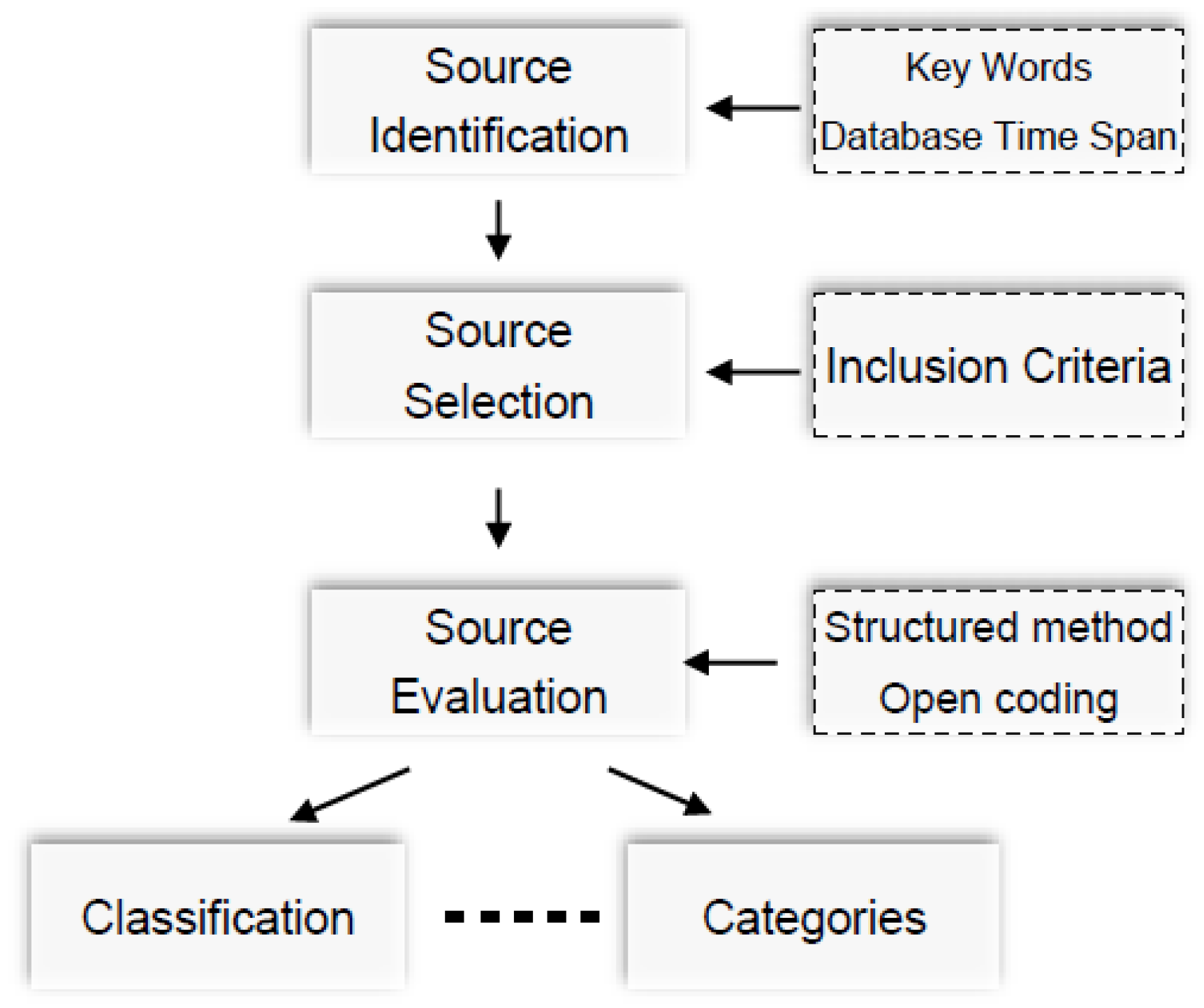
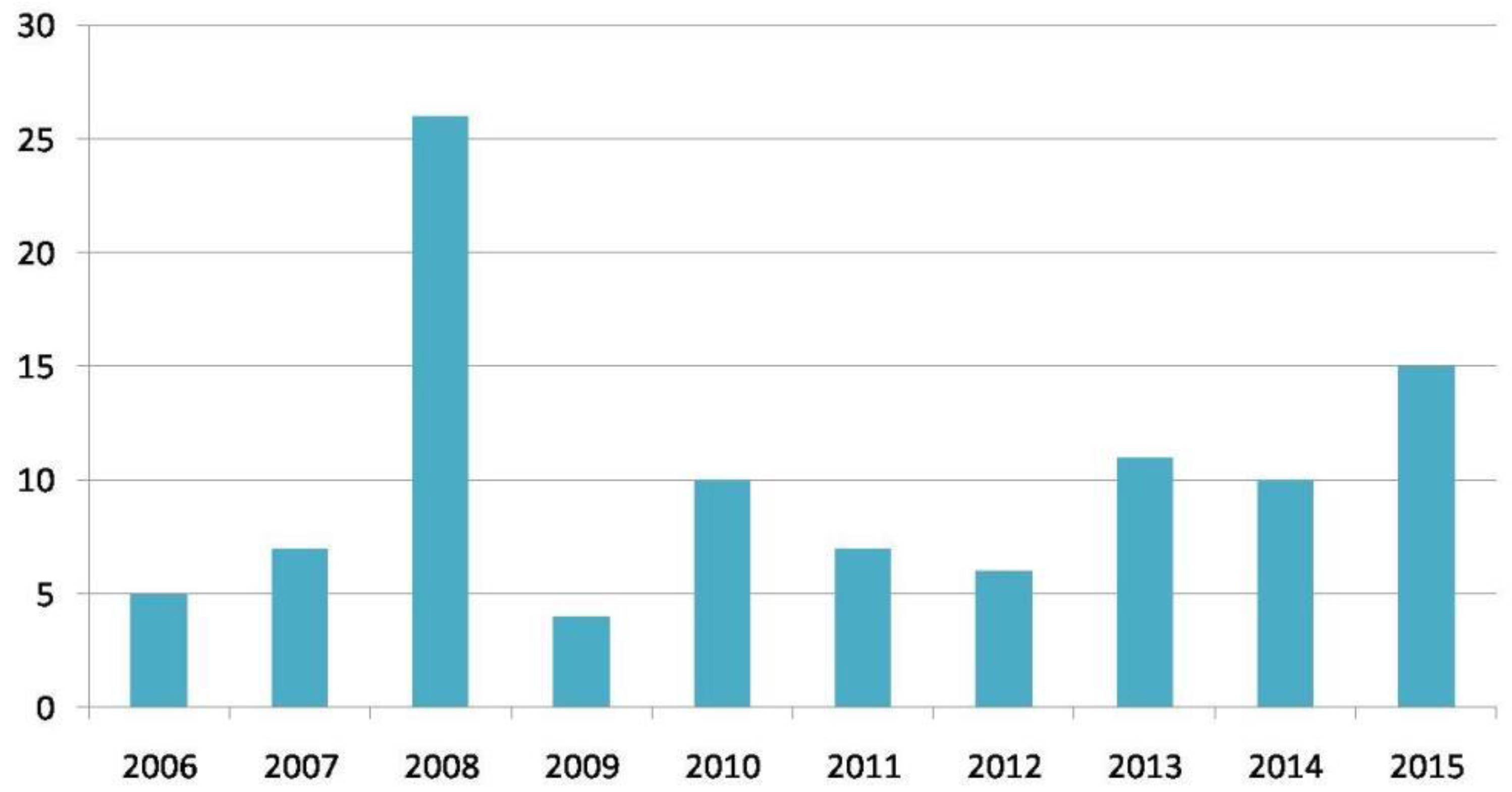

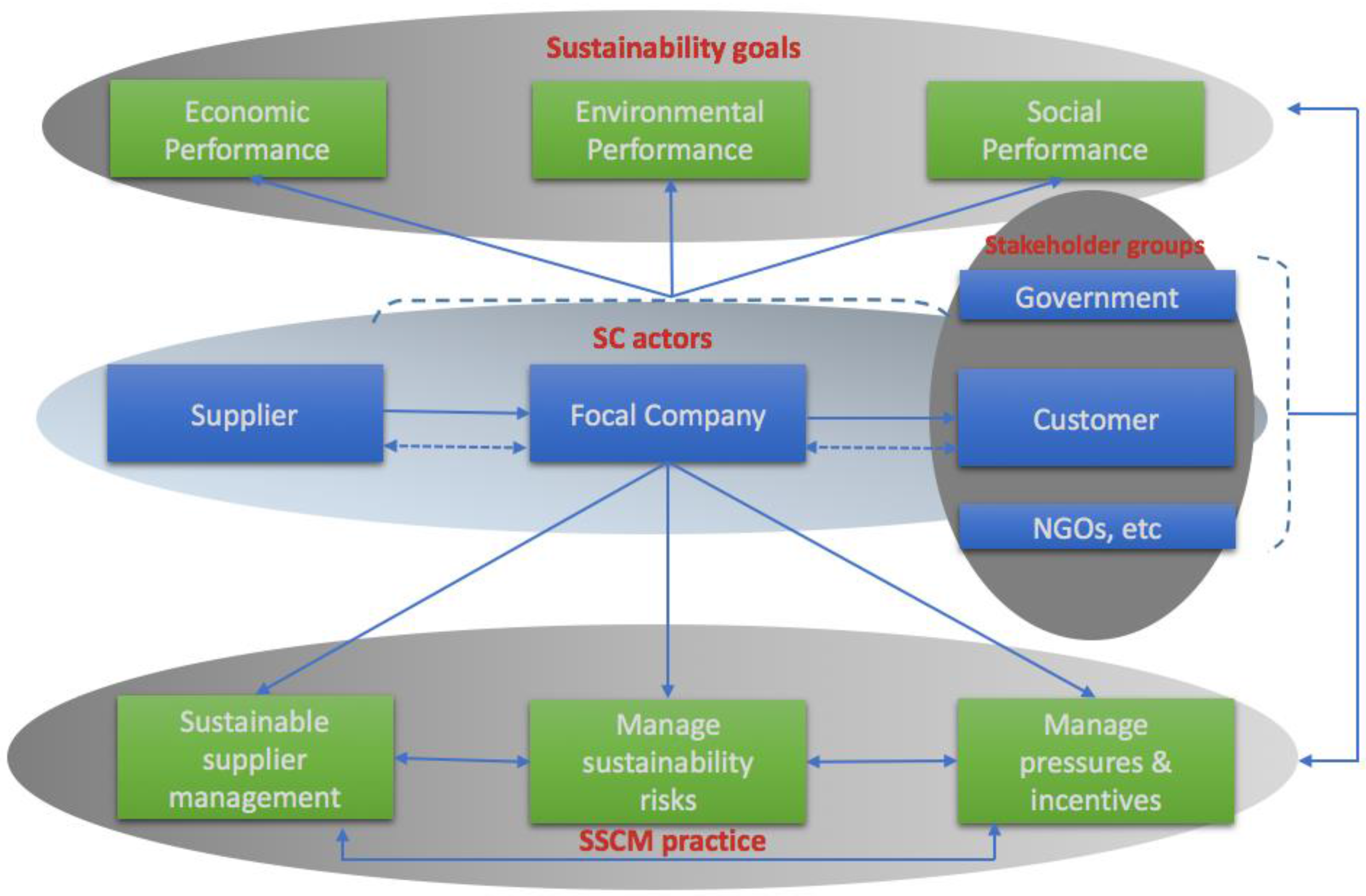
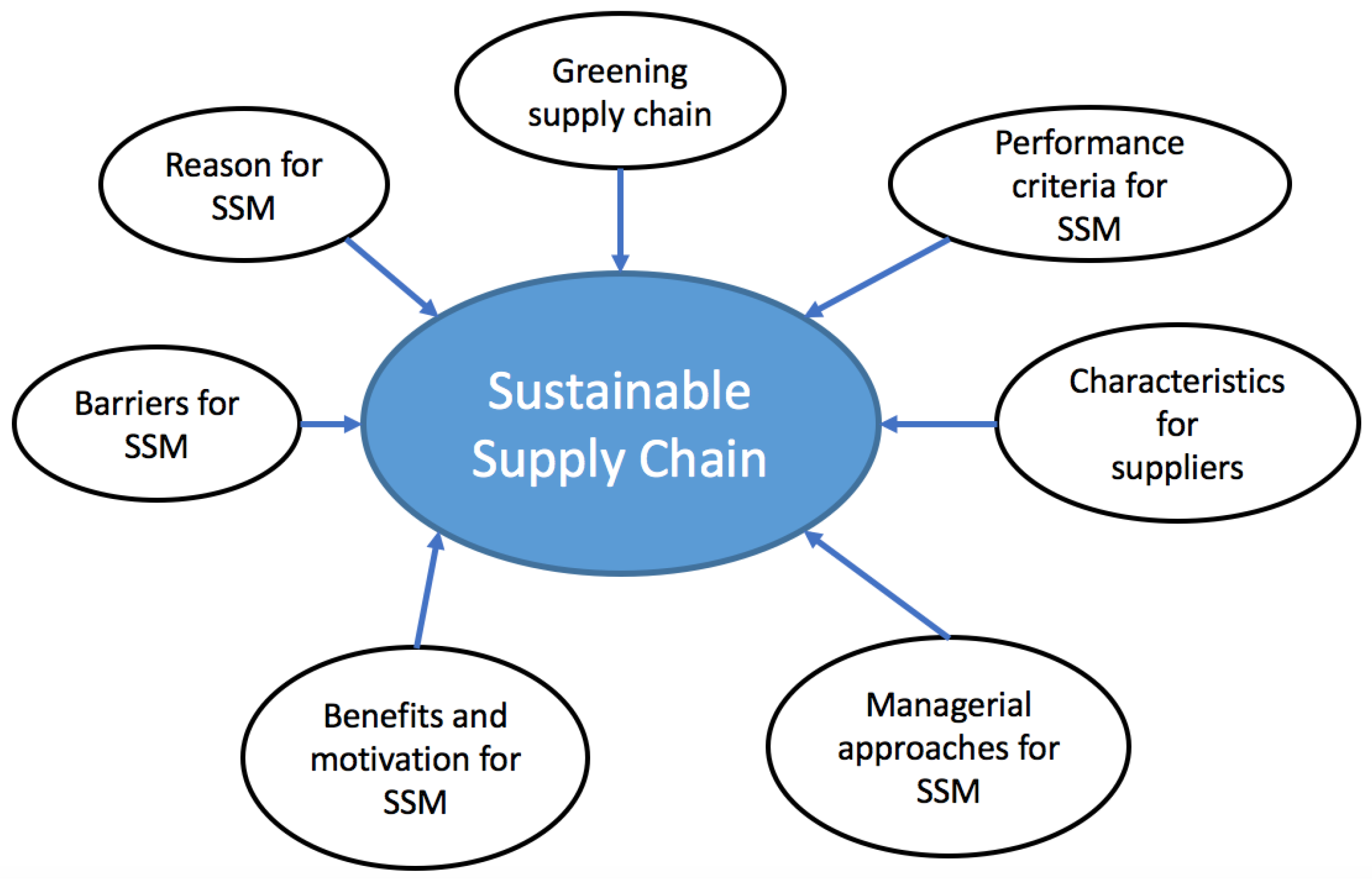
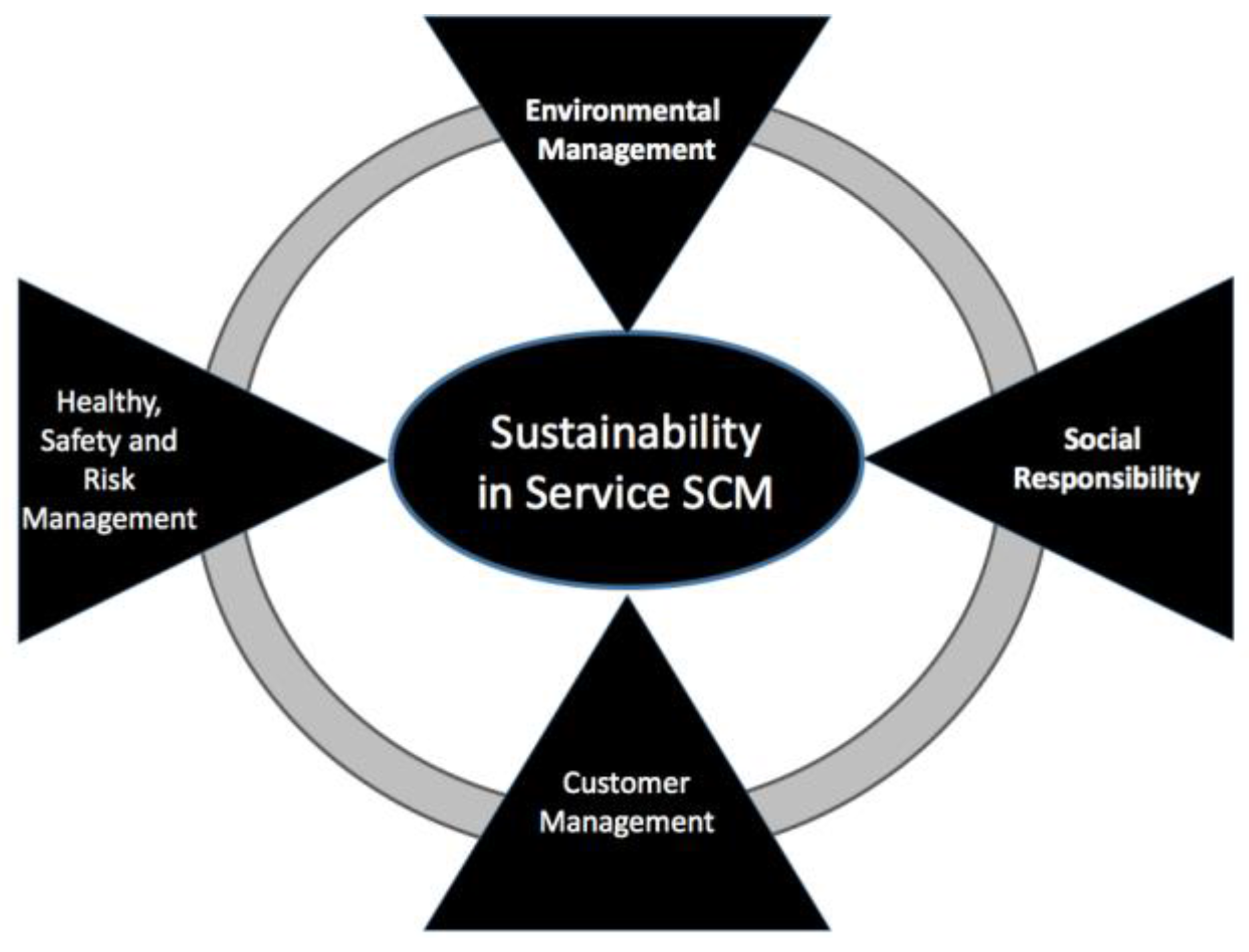
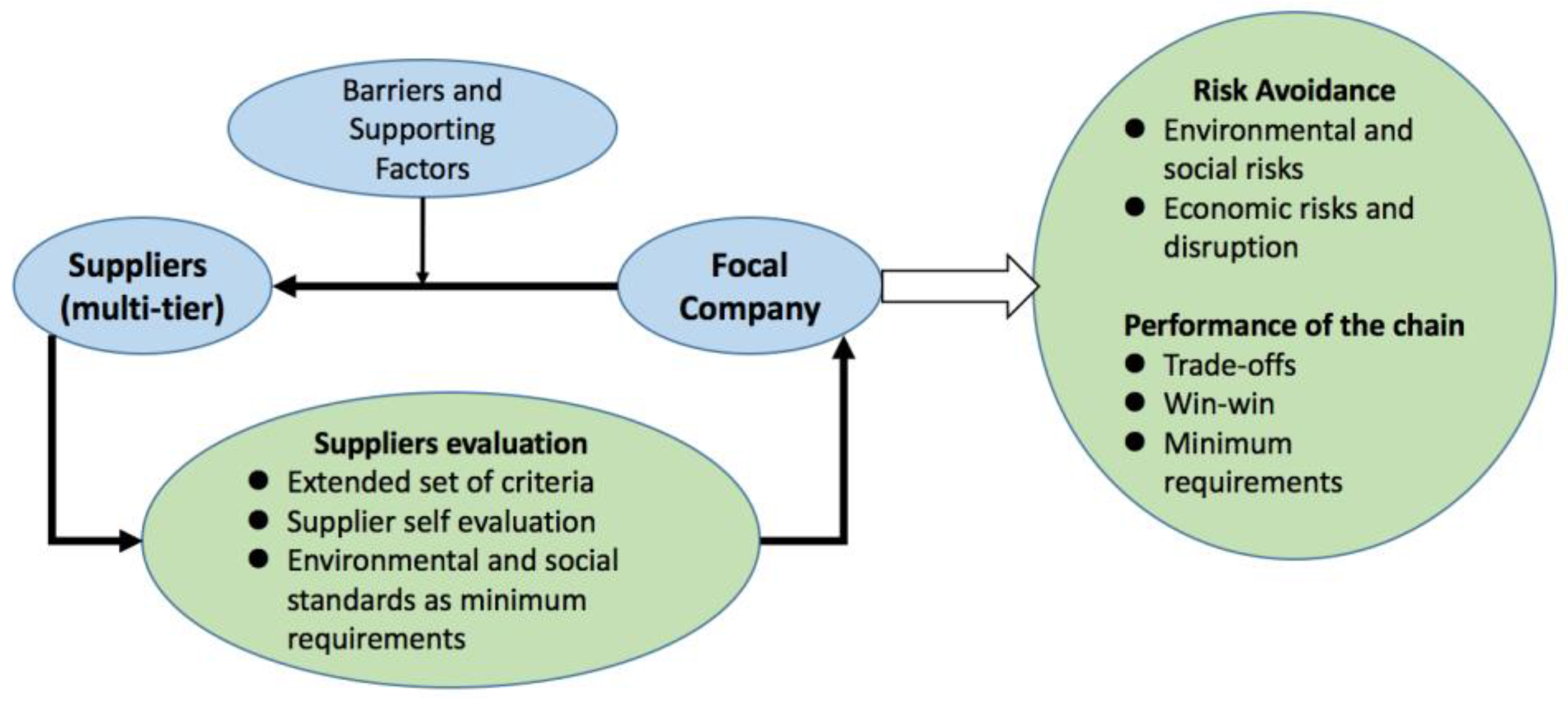
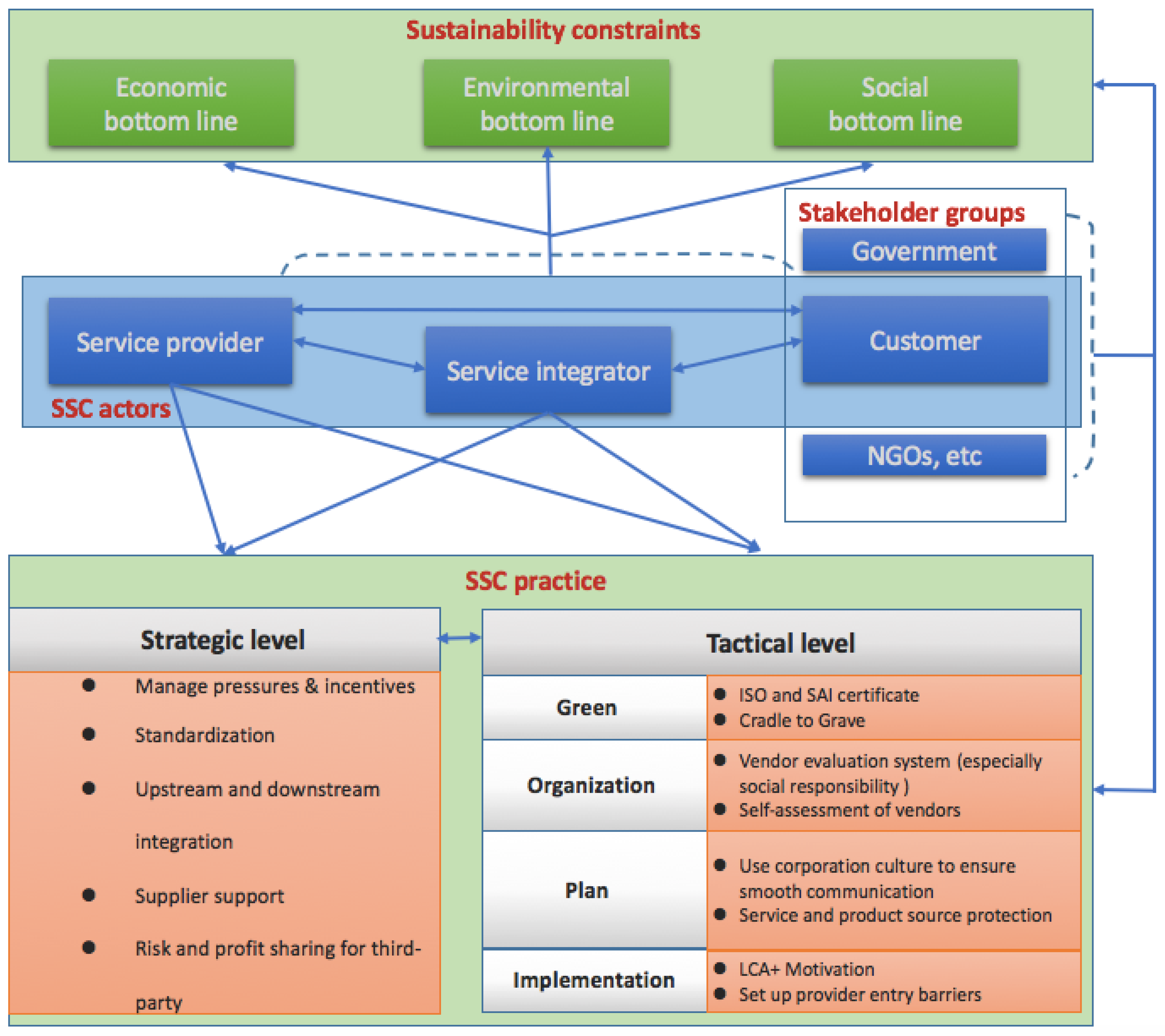
| Database | Initial Identified |
|---|---|
| Web of Science | 2197 |
| Emerald | 93 |
| ProQuest Central | 762 |
| ScienceDirect | 4364 |
| Wiley | 278 |
| Taylor & Francis | 207 |
| Total | 7901 |
| Database | Initial Identified |
|---|---|
| Web of Science | 179 |
| Emerald | 23 |
| ProQuest Central | 86 |
| ScienceDirect | 389 |
| Wiley | 85 |
| Taylor & Francis | 36 |
| Total | 798 |
| Database | Ultimately Identified |
|---|---|
| Web of Science | 101 |
| Emerald | 31 |
| ProQuest Central | 28 |
| ScienceDirect | 53 |
| Wiley | 18 |
| Taylor & Francis | 17 |
| Total | 248 |
| Journal | Numbers |
|---|---|
| International Journal of Production Economics | 23 |
| Sustainability | 18 |
| Renewable and Sustainable Energy Reviews | 6 |
| International Journal of Life Cycle Assessment | 10 |
| International Journal of Production Research | 9 |
| Energy | 8 |
| Omega | 7 |
| European Journal of Operational Research | 9 |
| Journal of Clean Production | 8 |
| Computers and Chemical Engineering | 3 |
| Total | 101 |
| Authors | Year | Type | Journal Title | Research Field | Main Conclusion |
|---|---|---|---|---|---|
| Hussain, Khan, and Al-Aomar | 2015 | Quantitative | Renewable and Sustainable Energy Reviews | S | Use sustainable view to build and design their network for managers, from providers to customers. |
| Cassini, Surti, and Searcy | 2012 | Qualitative | International. Journal of Production Economics | M/S | Presentations of a sustainable supply chain unique concept. |
| Wu and Pagell | 2011 | Qualitative | Journal of Operations Management | M | In the uncertain case, how organization make supply chain decisions when balancing short-term gains and long-term environmental sustainability. The article found that business managers when making environmental factors decisions will consider the short-term benefits. |
| Winkler | 2011 | Quantitative and Qualitative | CIRP Journal of Manufacturing Science and Technology | M | Proposed the concept of a sustainable supply chain network closed-loop manufacturing system, as well as four steps for success. |
| Chaabane, Ramudhin, and Paquet | 2010 | Quantitative and Qualitative | International. Journal of Production Economics | M | This paper uses a framework based on mixed integer linear programming to consider the sustainable supply chain life cycle assessment. An effective carbon management strategy can help decision makers achieve a cost-effective sustainability goal. |
| Gupta, and Omkar | 2011 | Qualitative | IIMB Management Review | M | A general framework is proposed, showing that the existing studies focuses on four broad aspects: 1 Strategic considerations 2 Functional level decisions 3 Laws and regulations 4 Integral models and decision support tools. |
| Securing and Muller | 2008 | Qualitative | Journal of clean production | M/S | This paper discusses the barriers to supply chain sustainability from the perspective of sustainable external factors in the service supply chain, and provides a conceptual framework to illustrate how to manage the supplier’s risk and performance. |
| Peano, Tecco and Dansero | 2015 | Quantitative and Qualitative | Sustainability | S | A conceptual framework for sustainable assessment of small fresh agricultural supply chains has been proposed and validated with ten small fresh agricultural products systems. It was confirmed that the conceptual framework could be used for sustainable prediction of fresh agricultural product supply chain. |
| Brandenburg and Rebs | 2015 | Quantitative and Qualitative | Annals of Operations Research | M/S | There are vacancies in SCM models regarding pressure and motivation, as well as risk and supplier management. |
| Tseng and Divinagracia | 2015 | Quantitative and Qualitative | Industrial Management and Data Systems | M | The first consideration in the sustainable environment should be the stakeholder indicators, followed by green design, cooperative sustainability, environmental management strategy design, cost-saving supplier motivation and market share. |
| Ageron, Spalanzani, and Gunasekaran | 2011 | Qualitative | International Journal of Production Economics | M/S | A conceptual framework for a sustainable supply chain is constructed and verified with examples (in the French region). |
| Beske, Land, and Seuring | 2013 | Qualitative | International Journal of Production Economics | M/S | Applications of SSCM help companies continue to control their entire supply chain, and provide competitive advantage. |
| Aminia, Carol and Bienstockb | 2014 | Qualitative and Quantitative | Journal of Operations Management | M | Based on literature review, this paper has drawn a conclusion on the sustainable behavior and framework of the tangible business, discovered the potential synergies between sustainability and innovation. |
| Chardine-Baumann and Botta-Genoulaz | 2014 | Quantitative | Computers and Industrial Engineering | M | This paper has considered all three aspects of sustainability (total cost, GHG emissions and lead time), and proposed an optimal framework for multi-objective scenarios to optimize the sustainable supply chain. |
| Brandenburg and Rebs | 2015 | Qualitative | Annals of Operations Research | M/S | This paper summed up quantitative research on sustainable supply chains and found vacancies for future research. |
| Bottom Line | Provider | Core Enterprises (Integrators) | Clients |
|---|---|---|---|
| Environment |
|
|
|
| Society |
|
|
|
| Economy |
|
|
|
| Bottom Line | Providers and Clients | Core Enterprises (Integrators) and Clients | Providers and Integrators |
|---|---|---|---|
| Economy |
|
|
|
| Society |
|
|
|
| Environment |
|
|
|
© 2017 by the authors. Licensee MDPI, Basel, Switzerland. This article is an open access article distributed under the terms and conditions of the Creative Commons Attribution (CC BY) license ( http://creativecommons.org/licenses/by/4.0/).
Share and Cite
Liu, W.; Bai, E.; Liu, L.; Wei, W. A Framework of Sustainable Service Supply Chain Management: A Literature Review and Research Agenda. Sustainability 2017, 9, 421. https://doi.org/10.3390/su9030421
Liu W, Bai E, Liu L, Wei W. A Framework of Sustainable Service Supply Chain Management: A Literature Review and Research Agenda. Sustainability. 2017; 9(3):421. https://doi.org/10.3390/su9030421
Chicago/Turabian StyleLiu, Weihua, Enze Bai, Liwei Liu, and Wanying Wei. 2017. "A Framework of Sustainable Service Supply Chain Management: A Literature Review and Research Agenda" Sustainability 9, no. 3: 421. https://doi.org/10.3390/su9030421
APA StyleLiu, W., Bai, E., Liu, L., & Wei, W. (2017). A Framework of Sustainable Service Supply Chain Management: A Literature Review and Research Agenda. Sustainability, 9(3), 421. https://doi.org/10.3390/su9030421






